Punjab State Board PSEB 6th Class Science Book Solutions Chapter 11 Light Shadows and Reflections Textbook Exercise Questions and Answers.
PSEB Solutions for Class 6 Science Chapter 11 Light Shadows and Reflections
Science Guide for Class 6 PSEB Light Shadows and Reflections Intext Questions and Answers
Think and Answer (Textbook Page No. 109)
Question 1.
Classify different objects depending on whether an object allows light to pass through it completely, partially or not at all.
Answer:
Depending upon the amount of light passing through the object we can classify objects into the following three types.
- Transparent objects. Those objects which allow light to pass through them completely.
- Translucent objects. Those objects which allow only partial amount of light to pass through them.
- Opaque objects. Those objects which do not allow light to pass through them at all.
Question 2.
Classify the objects given in following table as transparent, opaque or translucent.
| Object/material | Transparent/opaque/translucent |
| Water | |
| Tissue paper | |
| Stone | |
| Air | |
| Book | |
| Mirror | |
| Thin cloth |
Answer:
| Object/material | Transparent/opaque/translucent |
| Water | Transparent |
| Tissue paper | Translucent |
| Stone | Opaque |
| Air | Transparent |
| Book | Opaque |
| Mirror | Transparent |
| Thin cloth | Translucent |
![]()
Think and Answer (Textbook Page No. 109)
Question 1.
Light travels in ……………. line path.
Answer:
Light travels in straight line path.
Question 2.
Light cannot pass through …………….. material.
Answer:
Light cannot pass through opaque material.
Think and Answer (Textbook Page No. 111)
Question 1.
For shadow formation, how many things are required ?
Answer:
For shadow formation, the following three things are required :
- Source of light.
- An opaque object and
- For getting shadow a surface or screen (which may be a wall or it can be earth surface)
Question 2.
A shadow is observed, on a screen, when an …………….. object comes in between
screen and a source of light.
Answer:
A shadow is observed on a screen, whenever an opaque object comes in between screen and a source of light.
Think and Answer (Textbook Page No.112)
Question 1.
The size of shadow of a given opaque object depends on relative ………….. of source of light and the opaque object.
Answer:
The size of shadow of a given opaque object depends on relative position of source of light and the opaque object.
Question 2.
What may be the colour of opaque object, shadow will always be …………….. (black/white)
Answer:
What may be the colour of opaque object, shadow will always be black.
Think and Answer (Textbook Page No. 115)
Question 1.
Pin-hole camera is based on the fact that in ordinary conditions light travel in ………………… path.
Answer:
Pin-hole camera is based on the fact that in ordinary conditions light travel in straight line path.
Question 2.
The images formed by pin-hole camera is …………….. and ………………..
Answer:
The images formed by pin-hole camera is inverted and small.
![]()
Think and Answer (Textbook Page No. 116)
Question 1.
A mirror does not change the direction of light that falls on it. (True/False)
Answer:
False.
Question 2.
A polished or shining surface like plane miror produces reflection.
Answer:
A polished or shining surface like plane mirror produces regular reflection.
PSEB 6th Class Science Guide Light Shadows and Reflections Textbook Questions and Answers
Exercise – 1
1. Fill in the Blanks:
(a) An object that allow light to pass through them partially are known as …………….. object.
Answer:
Translucent
(b) Light source like the sun that emit light of their own are called …………… objects.
Answer:
Luminous
(c) Never ever look directly at the Sun because it could be extremely …………… for the eyes.
Answer:
harmful
(d) The change in direction of propagation of light when light allowed to fall on polished
surface is called ……………….. of light.
Answer:
Reflection
(e) Due to ……………… phenomenon rooms are lighted up in day time though no direct
sunlight enters the room.
Answer:
irregular reflection
![]()
2. Write True or False:
(a) Moon is a luminous object.
Answer:
False
(b) We can clearly see through transparent material.
Answer:
True
(c) Shadow of opaque object is always black.
Answer:
True
(d) Light doesn’t travel in straight line path.
Answer:
False
(e) Due to reflection of light, rooms are lighted up during day time though no direct sunlight enters the room.
Answer:
True
3. Match the Column A with Column B:
| Column A | Column B |
| 1. Natural sources of light | (a) Light moves along a straight path |
| 2. CFL, LED and tube light | (b) Opaque object |
| 3. Rectilinear propagation of light | (c) Shadow cast by a heavenly body |
| 4. Eclipse | (d) Man-made sources of light |
| 5. Cardboard, wood and metal | (e) Sun, stars and firefly. |
Answer:
| Column A | Column B |
| 1. Natural sources of light | (e) Sun, stars and firefly |
| 2. CFL, LED and tube light | (d) Man-made sources of light |
| 3. Rectilinear propagation of light | (a) Light moves along a straight path |
| 4. Eclipse | (c) Shadow cast by a heavenly body |
| 5. Cardboard, wood and metal | (b) Opaque object. |
4. Choose the Correct Answer:
Question (i)
Objects, like moon, which do not emit light of their own, are called:
(a) Luminous objects
(b) Absorbers of light
(c) Non-luminous objects
(d) Reflectors of light.
Answer:
(c) Non-luminous object
![]()
Question (ii)
An object, through which we can see partially, but not very clearly, is:
(a) A rubber ball
(b) A sheet of plane glass
(c) A sheet of tracing paper
(d) A compact disk.
Answer:
(c) A sheet of tracing paper
Question (iii)
When sun (during evening) is behind an object, the size of its shadow in comparison to that of the object M ould be:
(a) Smaller
(b) Almost zero
(c) Larger
(d) Equal.
Answer:
(C) Larger
Question (iv)
The image, formed by a pinhole camera, is:
(a) Inverted and diminished
(b) Inverted and enlarged
(c) Erect and enlarged
(d) Erect and diminished.
Answer:
(a) Inverted and diminished
Question (v)
For shadow formation, we require :
(a) An opaque object
(b) A source of light
(c) The screen to obtain the shadow
(d) All of the above.
Answer:
All of the above
5. Very Short Answer Type Questions:
Question (i)
State the type of path that light ordinarily follows while going from one point to another.
Answer:
Light follows straight line path.
Question (ii)
Fishes do not cast shadow in water. Why ?
Answer:
Fishes do not cast their shadows when the bed river or swimming pool which acts as a screen is far away from the fishes.
Question (iii)
State the relative position of sun, earth and the moon during solar eclipse.
Answer:
During solar eclipse, the position sun will be between earth and the moon and the
three are in a straight line.
![]()
Question (iv)
In a completely dark room, if you hold a mirror in front of you, will you see a reflection of yourself in the mirror ?
Answer:
If you hold a mirror in front of you in a completely dark room you cannot see your image because light is required for formation of image.
Question (v)
Two identical bed sheets, of pink and grey colour are hanging on a rope under the sun. What would be the colour of shadow of these two bed sheets ?
Answer:
We know that the shadow of an opaque object is always black. The colour of shadow does not depend on the colour of an object. So the colour of shadows of these two bed sheets would be black.
6. Short Answer Type Questions:
Question (i)
What is regular reflection ?
Answer:
Regular reflection. When light falls on a plane mirror or smooth and polished surface of some metal then it is reflected in a regular manner. This type of reflection is known as regular reflection.
Question (ii)
Why shadow in afternoon is smaller than shadow formed in the morning ?
Answer:
During noon the sun is vertically above our head and the sun rays directly fall on the
objects so that a small image is formed whereas in the morning the sun rays fall obliquely resulting in a large shadow. The size of the shadow depends upon the position of the source of light relative to the object.
7. Long Answer Type Questions:
Question (i)
Using suitable diagrams show that size of shadow formed, depends on relative position of the source of light and the opaque object.
Answer:
It is clear from the figure that by increasing the distance between the source of light and the opaque body the size of the shadow decreases. And if the distance between the source of light and the opaque object decreases the size of the shadow becomes light. Thus we can say that the size of shadow formed depends on the relative position of source of light and the opaque object.
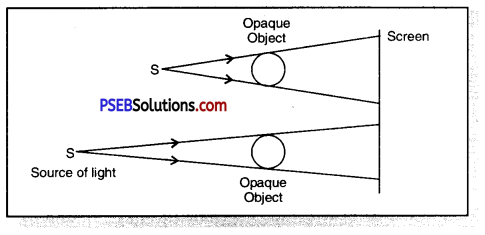
Question (ii)
Using diagram, show the formation of image by pinhole camera.
Answer:
Pinhole camera. It is a simple camera which can be made from wood or cardboard box. Take two boxes such that one can slide into the other tube easily.
Cut the small flaps of one side of each box. Make a hole in the centre of other side of big box. Similarly cut a rectangular flap in the centre of other side of small box. Put a piece of tracing paper on this cut. Slide the smaller box inside the bigger box. A pinhole camera is ready.
Working. Try to view from the open side of small box. Cover your head and box with a black cloth. View some trees or far off objects. Fix camera on object which is completely under sunlight. Slide small box inside bigger box so that a picture can be obtained on butter paper.
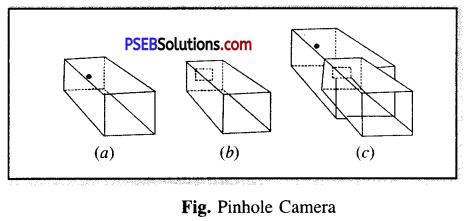
Formation of sun’s shadow with pinhole camera.
To make shadow of sun, we need a big cardboard sheet with a pinhole in centre. Hold this sheet in front of sun to get a clear shadow. We will see round image of sun in the centre of the cardboard sheet.
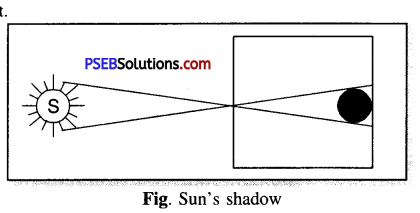
![]()
PSEB Solutions for Class 6 Science Light Shadows and Reflections Important Questions and Answers
Multiple Choice Questions:
Question 1.
The substance through which light can pass is called:
(a) Translucent
(b) Opaque
(c) Transparent
(d) None of these.
Answer:
(c) Transparent
Question 2.
For formation of shadow, the object in the path of light should be:
(a) Transparent
(b) Opaque
(c) Traslucent
(d) None of these.
Answer:
(b) Opaque
Question 3.
Seeing across Translucent objects is possible:
(a) Completely
(b) Partially
(c) Not at all
(d) None of these.
Answer:
(b) Partially
Question 4.
Luminous bodies:
(a) Emit light
(b) Do not emit light
(c) Take light from other body and then emit light
(d) None of these.
Answer:
(a) Emit light
Question 5.
Moon is a body:
(a) Luminous
(b) Non-luminous
(c) Both luminous and non-luminous
(d) None of these.
Answer:
(b) Non-luminous
Question 6.
During reflection, light after striking polished surface is:
(a) Sent back into the same medium
(b) Is passed on to the other medium
(c) Some part of light returns to the same medium
(d) None of these.
Answer:
(a) Sent back into the same medium
Question 7.
Reflection of light occurs at :
(a) Regular surface
(b) Irregular surface
(v) Some part of the surface is regular and some part is irregular.
Answer:
(a) Regular surface
![]()
Question 8.
When an opaque object is brought near a source of light, then :
(a) The size should become equal to that of the object
(b) The size of the shadow becomes smaller
(c) The size of the shadow increases
(d) None of these.
Answer:
(d) None of these.
Question 9.
The image formed in a pinhole camera is of :
(a) Object situated near
(b) Distant object
(c) Distant object at rest
(d) None of these.
Answer:
(b) Distant object
Question 10.
The shadow of a transparent object is :
(a) Dark black
(b) Circular
(c) Large sized
(d) None of these.
Answer:
(d) None of these.
Fill in the Blanks:
(a) Those objects through which light can not pass completely are called ……………….. objects.
Answer:
Translucent
(b) An opaque object placed in the path of light rays coming from source of light forms a black region behind the object which is called ………………
Answer:
Shadows
(c) Reflection of light occurs from surface of a ……………..
Answer:
mirror
(d) Irregular reflection of light takes place from a …………….. surface.
Answer:
rough
![]()
(e) Images of sun and other luminous objects are formed by ………………….
Answer:
Pinhole camera
Write (T) against true and (F) against false statements:
(a) The size of the shadow of an object does not depend on the position of source of light.
Answer:
False
(b) During lunar eclipse the moon is in between sun and earth and three are in a straight line.
Answer:
False
(c) Light travels in a straight line and does not bend around large objects.
Answer:
True
(d) Moon is a non-luminous body.
Answer:
True
(e) Taking source of light away from an opaque object forms large shadow of the object.
Answer:
False
Match the following :
Match statement of column A with that of Column B.
| Column A | Column B |
| 1. Light travels in straight line | Earth lies in between moon and sun. |
| 2. Lunar eclipse | Formation of shadow |
| 3. Solar eclipse | Pinhole camera. |
| 4. Inverted and small image | Opaque objects, source of light and screen |
| 5. Shadows | Moon is between Earth and Sun. |
Answer:
(1) Light travels in straight line – Formation of shadow.
(2) Lunar eclipse – Earth lies in between moon and sun.
(3) Solar eclipse – Moon is between Earth and Sun.
(4) Inverted and small image – Pinhole camera.
(5) Shadows – Opaque objects, source of light and screen.
![]()
Very Short Answer Type Questions
Question 1.
What is luminous body ?
Answer:
Luminous body. An object which gives out light of its own is called luminous body.
Question 2.
Name some luminous bodies.
Answer:
The sun, electric bulb, lighted candle, stars etc.
Question 3.
What are non-luminous bodies ?
Answer:
Non-luminous bodies. The bodies which donot give out light are called non-luminous bodies.
Question 4.
Name four non-luminous bodies.
Answer:
Card board, Table, Chair, Stone.
Question 5.
What is a transparent material ?
Answer:
Transparent. The matrial which comdpletely transmits light rays through it, is called transparent.
Question 6.
Name four transparent materials.
Answer:
Air, glass, water, alcohol.
Question 7.
What is an opaque material ?
Answer:
Opaque. The materials which do not allow the light to pass through them, are called opaque.
![]()
Question 8.
Name four opaque materials.
Answer:
Card board, Stone, wood piece and brick wall.
Question 9.
What is traslucent material ?
Answer:
Translucent. The material which transmits only part of light through it, is called translucent.
Question 10.
Name four translucent materials.
Answer:
Smoke, Fog, Butter paper, Rubber glass.
Question 11.
What is to be done to see shadow ?
Answer:
To see a shadow, place an opaque object in the path of source of light.
Question 12.
What are shadows ?
Answer:
Shadows. It is the dark space formed on the other side of the opaque object, when it is placed in the path of light.
Question 13.
Why should not we see directly towards the Sun ?
Answer:
It can affect our eyes.
Question 14.
How is image in a pinhole camera, possible ?
Answer:
When light travels in a straight line, then an inverted image is formed in a pinhole camera.
Question 15.
What is reflection of light ?
Answer:
Reflection of light. When a ray of light falls on a mirror/polished surface, it is sent back in to the same medium. This change of path of light is known as reflection of light.
![]()
Short Answer Type Questions
Question 1.
Is moon a Luminous or non-luminous body ?
Answer:
Moon is a non-luminous body as it does not give out light but reflects the sun light falling on its surface.
Question 2.
What are the conditions necessary for seeing objects ?
Answer:
Conditions necessary for seeing objects :
- The object to be seen
- Eye
- Presence of light
We cannot see objects in the dark. It is the light that helps us to see objects.
Question 3.
Differentiate between luminous and non-luminous bodies.
Answer:
Luminous bodies. Those bodies which give out light of their own are called Luminous bodies. For example, the Sun, the stars, jugnu, candle, an oil lamp etc.
Non-Luminous bodies. Some objects around us do not give out light themselves, but become visible only when light from a luminous body falls on them and some part of the reflected light enters our eyes.
Examples. Wood, Iron, cardboard and brick etc.
Question 4.
Why does an opaque body form shadow when light falls on it ?
Answer:
When light falls on an opaque body, it does not allow light to pass through it, so it forms its shadow.
Question 5.
What is a shadow ? What happens when an object is moved towards source of light ?
Answer:
Shadow. It is a dark space formed on the other side of the opaque object, when it is placed in the path of light. The opaque object does not allow the light to pass through it and light travels in a straight line only.
Question 6.
When we see some opaque object at height in the sun, black spots are seen on the earth. Why ?
Answer:
When we see some opaque objects at a height in the sun we notice some black spots on the earth which are shadows of the objects formed on the earth. Here earth acts as a screen.
Question 7.
Is a screen needed for shadow formation ? Which type of material, act as screen for shadows in daily life ?
Answer:
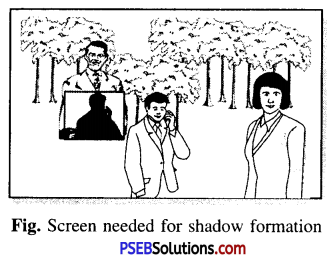
Yes, screen is needed for shadow formation as shadows can be seen on screens only.
Walls of a room, building and such surface etc. act as screen for shadows in daily life.
![]()
Question 8.
Show with an experiment that light travels in a straight line.
Answer:
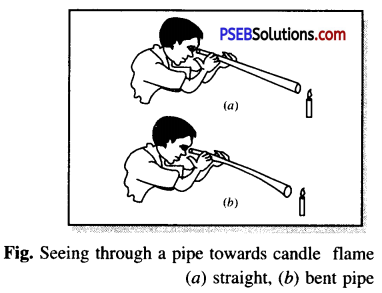
Take a small piece of long rubber pipe and place a candle on a table. Light the candle. Stand a little far away from the table and see the candle flame through the pipe. It is visible. Now bend the pipe or move it to the right or left and again look for the candle flame. The candle flame will disappear. This shows that light travels in a straight line.
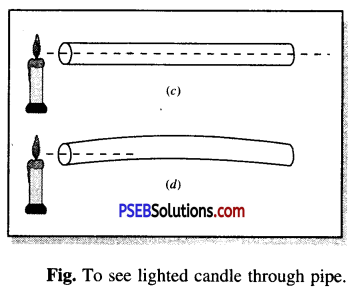
The reason is that light rays coming towards our eye through pipe is stopped due to bend. Since pipe is made up of opaque material, so light cannot pass through it. Hence light cannot reach our eye, due to which candle is not visible to us. This shows that light travels along a straight line.
Question 9.
What is reflection of light ? Which objects can cause reflection ?
Answer:
Reflection of light. The phenomenon of coming back of light into the same medium in a particular direction after falling on any surface, is called reflection of light. Ordinarily reflection takes place from polished surfaces but sometimes we see reflection of trees and buildings from water of tank or lake.
Question 10.
Classify the objects or materials given below as opaque, transparent or translucent luminous and non-luminous.
Air, water, a piece of rock, a sheet of aluminium, a miror, a wooden board, a sheet of polythene, a CD, smoke, a sheet of plane glass, fog, a piece of red hot iron, an umbrella, a lighted fluorescent tube, a wall, a sheet of carbon paper, the flame of a gas burner, a sheet of cardboard, a lighted torch, a sheet of cellophane, a wire mesh, kerosene stove, sun, firefly, moon.
Answer:
Opaque. A piece of rock, a sheet of aluminium, a wooden board, a CD, a sheet of carbon paper, a wall, a sheet of cardboard.
Transparent. Air, water, a sheet of plane glass.
Translucent. A sheet of cellophane, a sheet of polythene, smoke, fog, an umbrella, a wiremesh.
Luminous. A mirror, a lighted fluorescent tube, lighted torch, a flame of a gas burner, a piece of red hot iron, kerosene stove, sun, firefly.
Non-Luminous. A piece of rock, aluminium sheet, a wooden board, a sheet of cardboard moon.
Question 11.
Can you think of creating a shape that would give a circular shadow if held in one way and a rectangular shadow if held in another way ?
Answer:
A cylindrical box can give rectangular shadow when placed in vertical direction while a round/circular shadow when placed horizontally.
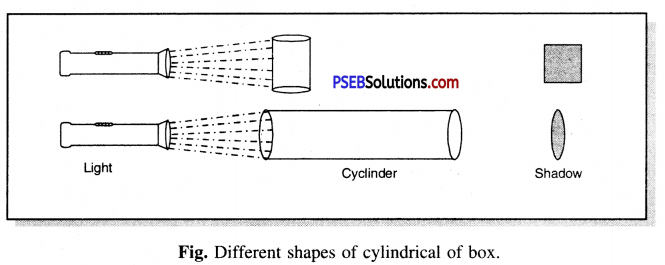
Question 12.
What are the conditions necessary for formation of shadow of an opaque objects ?
Answer:
For formation of shadow of an opaque object, the following conditions are necessary :
- A source of light
- An opaque object
- The screen (may be a wall or ground
![]()
Question 13.
What is Irregular Reflection ?
Answer:
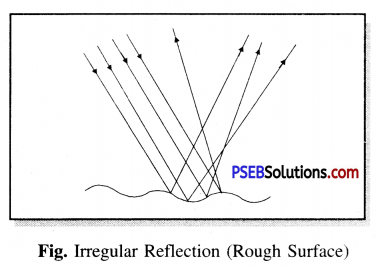
Irregular Reflection. When light falls on some rough or uneven surface then after reflection light gets scattered. Such type of reflection is called irregular reflection. Due to this phenomenon we see various objects around us.
Long Answer Type Questions
Question 1.
What is the reflection of light ? Show the phenomenon of reflection with the help of an activity.
Answer:
Reflection of light : The phenomenon coming back of light into the same medium after following on a smooth and polished surface is called reflection of light.
Activity 1.
Ask your friend to hold a plane mirror in his hand and stand in a corner of a dark room. Cover the glass of a torch with your palm and switch it on. To get a beam of light leave some space between your fingers. Throw this beam of light on the plane mirror held by your friend, you would notice the spots of light. Now change the direction of torch so that the image of some other friend standing in the room is formed in the mirror.
This activity shows that the mirror relflects the light falling on its surface.
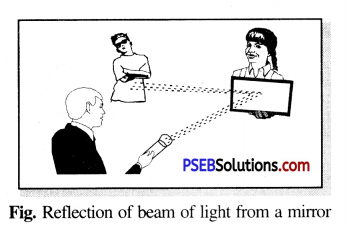
Activity 2.
Fix a comb on one side of a white thermocol sheet and fix a mirror on the other side as shown in fig. Fix a dark cloured sheet of paper between the comb and the mirror. Now project a beam of light from a torch through the comb on the mirror. You will see a pattern as shown in the figure.
This activity shows that mirror changes the direction of light that falls on it. which is due to reflection of light.
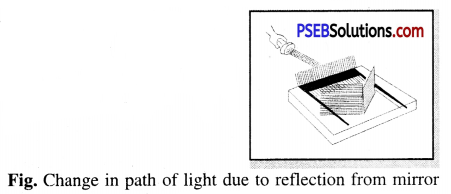
Question 2.
Show an activity to study the factors which are responsible to affect the size and colour of shadows.
Answer:
Study of factors that affect the size and colour of shadows:
Activity.
Throw a beam of light from a torch over a cubical block as shown in the figure to get its shadow on the ground. First, move the torch towards the cubical block and then away from it.
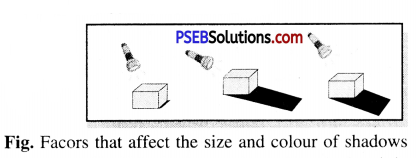
You will notice that when the torch is closer to the cubical block, the shadow is small and when it is away, the shadow is large in size.
Now use cubical blocks of different colours like chalk boxes, books, copies, tiffin boxes for getting shadows. You will see that in each case shadow is black.
In this way from the above activity we conclude:
- The size of the shadow of a given opaque object depends on the relative position of the source of light and the opaque object.
- The shadow of an opaque object is always black whatever may be the colour of the opaque object.
